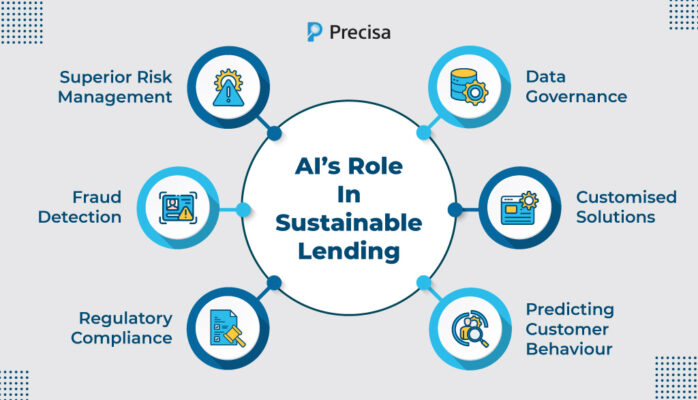Business Intelligence in the Banking Industry: Navigating Sustainable Lending with AI

Lending is one of the fastest-growing verticals in the industry. Capitalising on the large credit gap among both business and consumer borrowers, Banks, non-banking financial companies, and other lenders view it as a high-potential revenue stream.
However, the traditional banking ecosystem is not fully equipped to serve borrowers based on their diverse needs or execute the underwriting function accurately and without bias. Lack of comprehensive data and its efficient processing are challenges that stand in the way of lenders reaching their full potential.
This is where tools powered by Artificial Intelligence (AI) are bridging the gaps by enabling access to high-quality, superior business intelligence in the banking industry.
A McKinsey research indicates that the use of advanced AI tools can help the global banking ecosystem system unlock revenue to the tune of $ 1 trillion across areas through effective risk management and operational efficiency.
This blog explores the challenges faced by lenders today and how AI-first banks can address key problems and transform their lending verticals.
What Is Business Intelligence In The Banking Industry?
Business intelligence in the banking industry aims to understand consumer purchase behaviours and trends, enhance the consumer experience, understand and define consumer needs, boost operational performance, and strengthen regulatory compliance.
Business intelligence in the lending context is aligned to similar goals. It is geared towards addressing key challenges lenders face due to lack of data.
Today, there is no dearth of data available to businesses. From basic details such as name, address, and contact details, businesses can capture a borrower’s online engagement footprint, purchase history, and lifestyle needs.
However, lending businesses need access to superior tools to capture data comprehensively and organise, analyse, and store data securely. Tools that leverage AI, in particular, bring unique advantages, which can help lenders capitalise on available data.
Let’s understand the value of such tools in building a sustainable lending operation.
Business Intelligence in the Banking Industry: AI’s Role in Sustainable Lending
Today, AI-based financial analysis and loan management tools are helping lenders solve some of their top challenges and help shape a sustainable, profitable business.
Here are some ways AI is making a revolutionary impact in strengthening business intelligence in the banking industry.
Superior Risk Management
One of the biggest challenges lenders face is the inability to make accurate underwriting decisions. Reasons can range from lack of adequate borrower data to inability to analyse large volumes of data promptly and precisely due to manual underwriting processes.
These challenges stand in the way of lenders betting on borrowers who are more likely to repay loans on time or at all. The adoption of AI-driven financial analysis tools is flipping the narrative.
- Such tools can analyse large amounts of data efficiently by classifying all transactions into categories such as income, debt, loan repayment, etc. Based on the analysis, the tool generates a creditworthiness score, which enables businesses to make swift and precise lending decisions.
- These also enable businesses to look at alternate data points for borrowers without a credit history or assets that can be used as collateral.
For instance, lenders can review Goods and Services Tax Returns (GSTR) to confirm a business’s sales revenues and potential for proactive loan repayment.
Enabling Data Governance At Scale
Today, lenders are grappling with large volumes of data, which are humanly impossible to analyse and process without effective technology. AI can extract, process, and store massive amounts of data securely at scale.
Businesses can significantly reduce the potential for duplication and manipulation of data and errors by replacing manual processes with AI-driven data management.
Superior Capabilities To Detect Fraud
Loan fraud is a huge risk for lenders. AI tools can quickly recognise irregular financial transaction patterns and detect fraudulent documents due to minute differences. Thus, lenders can avoid falling prey to identifying fraud and fraudulent borrowers.
Offering Customised Solutions
AI-based financial analysis tools not only enable accurate underwriting decisions but also add additional value. For instance, they recommend customised solutions for borrowers based on their real-time credit needs and financial health.
The traditional culture of offering standardised products and services is being replaced by tailored solutions based on individual borrower realities.
This feature can help lenders stay relevant across all borrower segments, including underserved ones such as the Micro, Small, and Medium Enterprises (MSMEs).
Enabling Regulatory Compliance At Scale
Lending regulatory bodies are becoming more stringent due to the growth in loan fraud and fraudulent lending players. AI-enabled tools allow new compliance guidelines by regulatory authorities to be applied at scale across all steps of the lending workflow.
Thus, lenders can stay compliant and avoid the risk of paying penalties that eat into profits and investigations for potential fraud.
Predicting Future Customer Behaviour
As lenders analyse more and more data from customers and potential borrowers, they amass huge volumes of valuable data. AI-based loan management tools come with superior AI-based predictive analytics functionalities.
Hence, lenders can understand consumer behaviour in-depth and track customer financial trends. They can forecast future trends down to the minute, day, month, and year based on historical and real-time data. Lenders can make important business decisions based on future trends.
They can unlock new pipelines of revenue based on findings and respond to market needs ahead of the curve, thus becoming market leaders in new verticals.
Key Takeaway
AI-powered tools like bank statement analysis solutions enable lenders to make more accurate, data-driven decisions. They also enable lenders to deliver customised products to borrowers instead of a one-size-fits-all stack.
Banks, NBFCs, and other types of lenders can partner with technology specialists who bring AI automation expertise to the table. Early AI-powered interventions can help lenders reduce Non-Permoming Assets, drive revenues, and become profitable over a shorter timeline.
Presica’s comprehensive and seamless financial data analysis solution simplifies and speeds up the process through automation. The software provides actionable insights on a customisable dashboard, thus helping companies make informed business decisions.
Request a free demo today!



